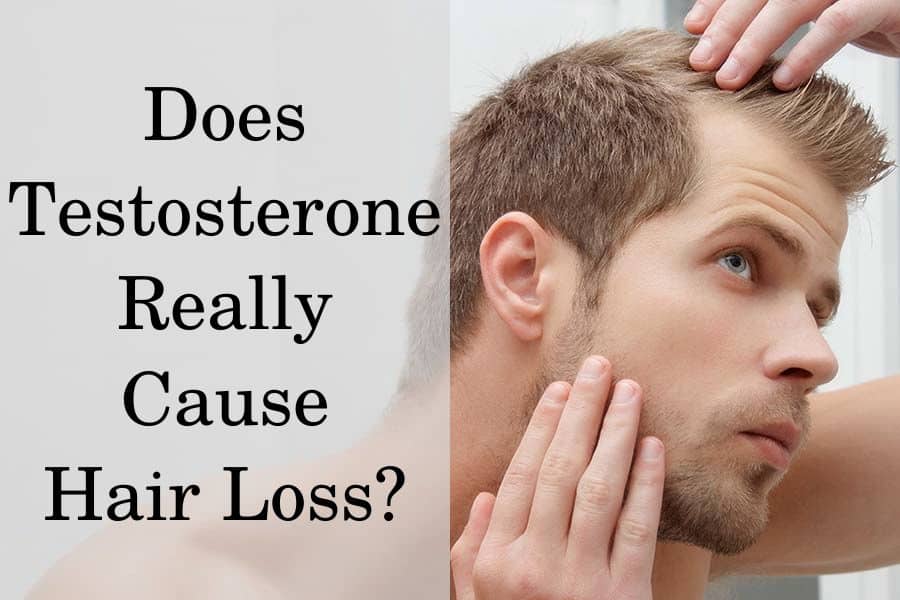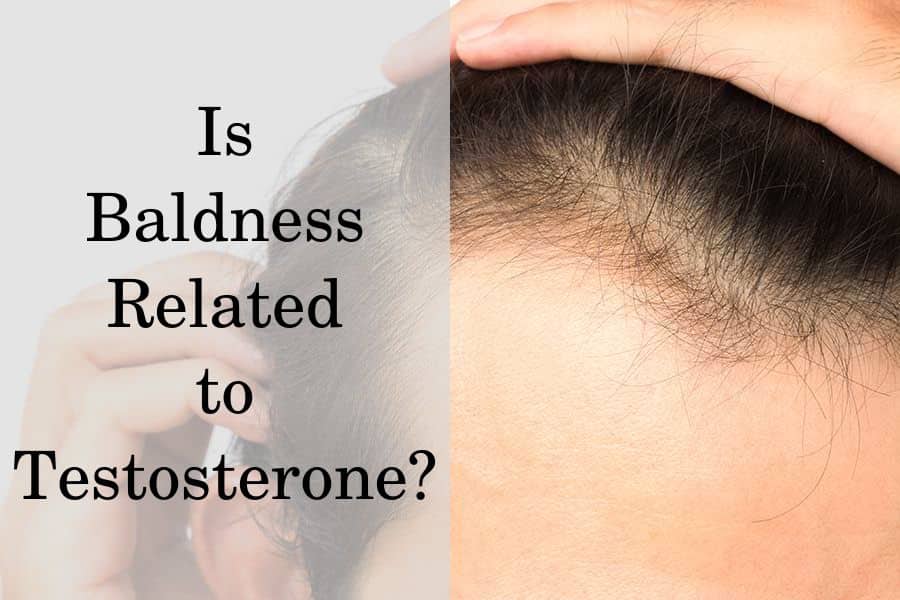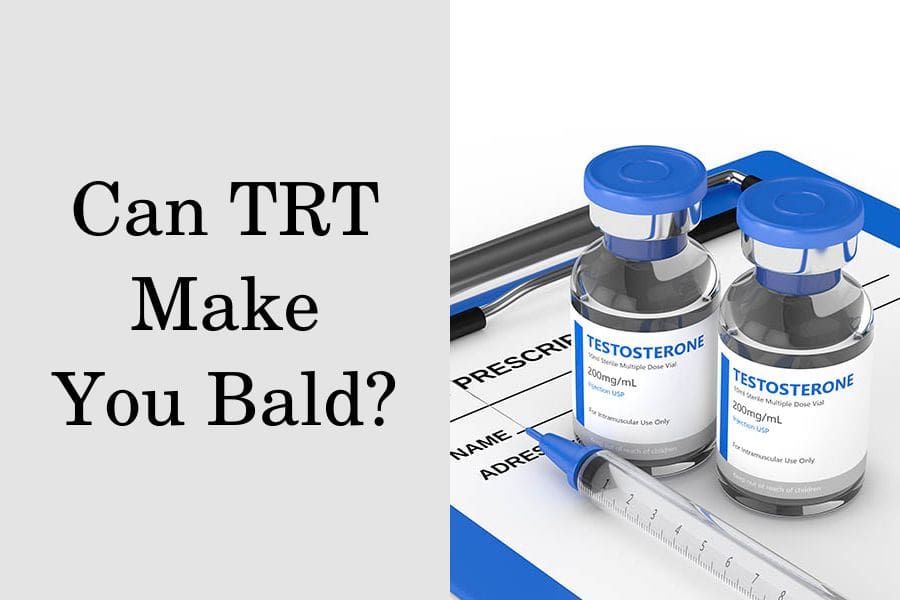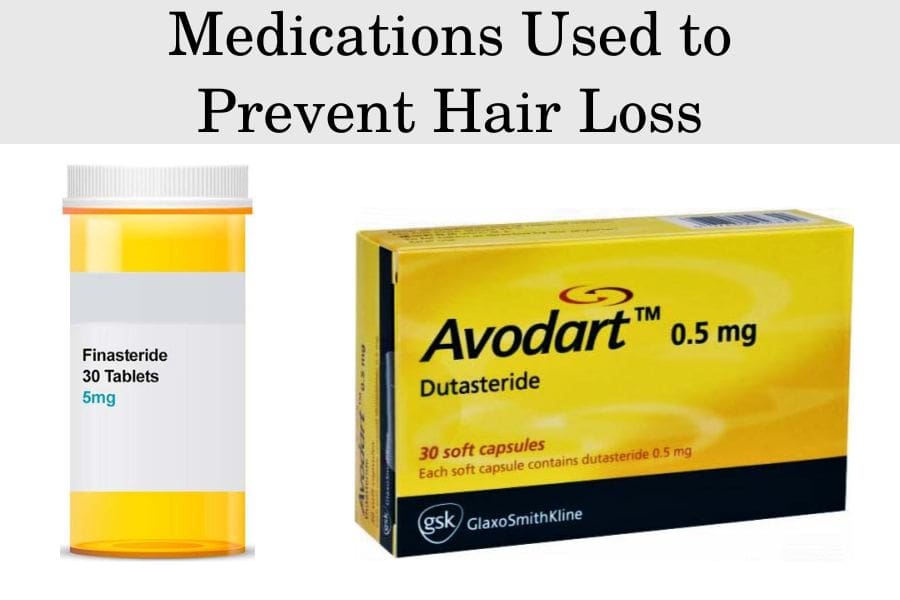Testosterone replacement therapy (TRT) is currently the most effective treatment that a doctor can prescribe to manage your symptoms if you have low testosterone (T).
But even when the therapy is prescribed and controlled by an experienced medical specialist, many men are concerned that it can lead to hair loss.
In reality, men on TRT do not experience hair loss more often than healthy males with normal T levels. That’s because the hormone itself does not affect hair growth directly, but it must first get converted to another androgen called dihydrotestosterone (DHT).
Moreover, there are genetically predetermined factors that determine the risk of hair loss. They include the rate of conversion of testosterone to DHT in your body and the individual sensitivity of your hair follicles towards DHT.
Furthermore, your body regulates DHT levels in peripheral tissues regardless of your serum DHT, so TRT in any form, including injections, gels, or pellets, can’t cause hair loss in individuals who were not predisposed to it in the first place.
That doesn’t mean that genetics is the only factor for hair loss. Other factors that can increase your risk of hair loss include your age, stress levels, and exposure to certain environmental toxins.
The link between testosterone and hair
Androgenic alopecia is the most common cause of hair loss in both men and women. The term androgenic means it is associated with male sex hormones such as testosterone and DHT. In fact, the condition cannot develop if a person has no T and DHT levels.
Furthermore, androgenic alopecia can occur only after puberty. However, there is a complex interaction between your hair growth and T levels, and having more testosterone does not mean that you will experience hair loss.
In fact, the rate of androgenic alopecia significantly increases with age, while T levels decrease. Studies show that testosterone-related hair loss affects about 15% of male adolescents, 50% of middle-aged men, and up to 80% of elderly individuals.
At the same time, testosterone is at its peak during puberty and progressively declines after the age of 30.
Studies reveal that the reason behind this paradox is that the risk of hair loss depends more on a person’s DHT receptor sensitivity rather than their DHT levels per se.
What is more, the human scalp has high concentrations of the 5-alpha-reductase enzyme, which normally converts testosterone into DHT. If the activity of that enzyme is high, this may increase the formation of DHT locally and also contribute to hair loss.
The activity of the 5-alpha-reductase enzyme and the sensitivity of DHT receptors in your scalp depends primarily on your genetics. This is why different studies report early-onset hair loss affecting men with high T but also those with low T levels.
Another paradox related to androgenic alopecia is that dihydrotestosterone has a different effect on hair, depending on the body part.
Studies reveal that DHT has anabolic effects on hair growth all over the body, including the head, except for the top and front areas of the scalp in men.
The hair follicles in these areas react to DHT by shrinking, which leads to progressively thinning hair and eventually causes baldness.
Does TRT cause hair loss?
Unfortunately, there are still no clinical studies investigating specifically the effect of TRT on the risk of baldness.
But TRT is unlikely to cause hair loss, considering the fact that having high testosterone naturally was not shown to increase the risk of alopecia, and instead, genetics play the main role.
It’s important to note that TRT can significantly increase the levels of dihydrotestosterone in your body. And the degree to which TRT increases serum DHT levels depends on the route of administration.
Transdermal TRT leads to a much higher DHT increase compared to intramuscular administration of testosterone. That’s because there is a much higher activity of the 5-alpha-reductase enzyme in the skin compared to muscle tissue.
However, studies show that TRT can increase serum T and DHT without affecting the levels of these hormones in androgen-sensitive tissues such as the skin.
That’s because there are local regulatory mechanisms that tightly control intracellular androgen homeostasis.
In other words, even if serum T levels are low, peripheral tissues such as the skin will still produce normal DHT levels, which may lead to baldness in susceptible individuals. Therefore, you may still experience hair loss even if you are taking a low dose of TRT.
Other tissues which are sensitive to high levels of dihydrotestosterone include the prostate and the sebaceous glands in the skin. Increased DHT may lead to increased production of sebum and a higher risk of acne.
In the prostate, DHT can also cause enlargement of the gland, which is known as benign prostate hyperplasia. This can lead to complaints such as difficulty urinating, sexual problems, and increased frequency of urination at night.
Also, hair loss is one of the possible side effects of testosterone therapy in females and may persist even after treatment is stopped.
Unlike TRT, dietary supplements such as testosterone boosters (Andro 400) and Test X180 Boost are not proven safe nor effective methods for increasing testosterone levels.
In fact, research on the 10 most common ingredients in testosterone boosters reveals that human studies on the topic are scarce. From the studies available, most reported no effect of the ingredient on T levels, while some even reported a decrease.
Therefore, testosterone boosters are not likely to increase or decrease the risk of androgenic alopecia.
How TRT affects facial and body hair
As we mentioned previously, DHT can actually speed up hair growth in most sites of your body, including your beard. In fact, it is the increase of testosterone during puberty that triggers and stimulates hair growth in males.
The facial hair in males is one of the skin areas which are most sensitive to androgens. And since testosterone can convert into dihydrotestosterone, taking TRT may increase your facial hair growth.
However, your facial and body hair growth during TRT also depends on genetics and individual sensitivity.
If your TRT dosage is regulated by a medical doctor, the therapy is not gonna cause excessive body hair growth or help you grow more facial hair than healthy individuals with normal testosterone levels.
How to prevent hair loss on TRT
If you are genetically predisposed to androgenic alopecia, then it’s best to take preventative measures against it. Most medications used to prevent or manage alopecia can also be taken during TRT.
Currently, the most effective measure is blocking the 5-alpha-reductase enzyme, which helps reduce dihydrotestosterone formation in the body, especially in the skin and the prostate.
Examples of FDA-approved DHT blockers include Finasteride and Dutasteride, and they can be safely taken alongside TRT. Finasteride has been tested extensively and shows great effectiveness in reducing hair loss in androgenic alopecia.
In one trial with over 3000 participants, 87% of them had improvement. The benefits usually occur within 3 months of using Finasteride and gradually improve over 6 months until the maximum benefit from Finasteride is reached.
Furthermore, there are topical medications that help increase blood flow to the hair follicles and thus stimulate their growth. One such topical vasodilator is Minoxidil. Daily use of Minoxidil on the scalp has been shown to slow down hair loss within 3 months of use.
In addition, scientists have also investigated natural options for blocking DHT formation, including extracts from saw palmetto, green tea, curcumin, and pumpkin seed oil.
For example, 6-month research on oral supplementation with pumpkin seed oil reveals that the method is safe and effective for reducing hair loss in men with mild to moderate alopecia.
Is testosterone hair loss reversible?
Whether hair loss is reversible or not depends primarily on how damaged your hair follicles are. Androgenic alopecia causes your follicles to shrink gradually and the hairs to become thinner and shorter.
Eventually, the follicles will become dormant, shedding the hairs and not growing new ones. This stage is still reversible.
However, if not treated promptly, the dormant follicles may die, which makes the balding irreversible. Currently, the most effective method to reverse the condition is using oral DHT blockers in combination with topical treatment.
Apart from medications such as Finasteride and Minoxidil, you may also consider lifestyle intervention that can help slow down and reverse the process before it’s too late.
These should include increased intake of vegetables, quitting smoking, and improving stress management.
Get a free consultation with our medical expert for any questions about hormone replacement therapy




